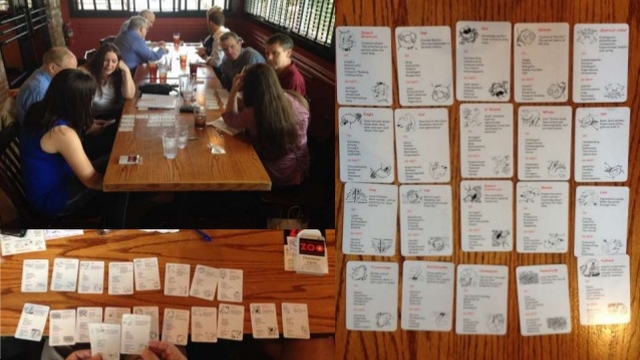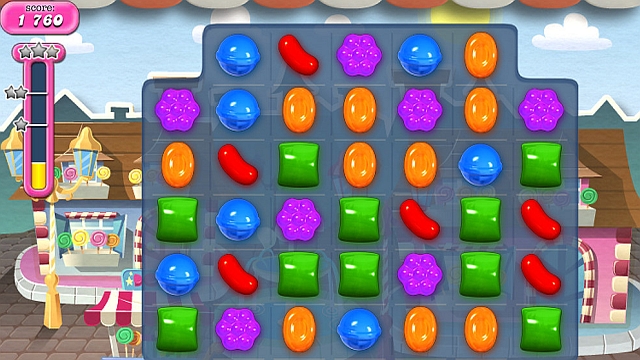
The use of gamification in knowledge management processes
We’ve previously reported on a paper that identifies the elements of gamification and then uses a case study to demonstrate how gamification can be used to support knowledge workers. Gamification is also being increasingly used and explored by knowledge management (KM) practitioners. For example, The Organisational Zoo Character Cards above provide the basis for productive games in KM.
A new study1 further investigates the use of gamification in knowledge management (KM) processes through a systematic literature review of recent papers.
Gamification refers to an emerging organizational practice that is defined by the use of game mechanics and design in a non-game context to measure, influence and reward target user behaviors. Gamification uses the essence of game features – goals, rules, fun elements, feedback, rewards and promotions – to solve day-to-day business problems.
According to recent studies, most organizations use gamification to motivate sharing, increase stakeholder engagement, and explore relationships with the external context, leveraging the organization’s social platforms and networking practice.
A positive impact
The systematic review identified 19 recent papers focused on the impact of gamification on KM, both on the KM system itself and on the creation, acquisition, sharing and transfer of knowledge.
The results of these 19 studies were analyzed and coded as positive, negative, or neutral. Fourteen (74%) of the studies reported positive results, that is, gamification improved the creation, acquisition, sharing and transfer of knowledge. Four of the studies (21%) reported neutral results, and only one reported some negative results.
Barriers to implementation
Of the analyzed paper, only three addressed barriers to the use of gamification as an organizational practice. The barriers identified in these papers can be classified as follows:
- Individuals – barriers related to the users of the game and how they face it. These barriers include employees’ involvement being only temporary, the learning that comes from gamification not being incorporated into daily activities, and users’ personality having an impact on their reaction to gamification in the workplace or loss of interest in the rewards offered.
- Infrastructure / game design – determined by the organization, in terms of its organizational structure and also by the game’s creator and the mechanisms used in its design. The studies refer, for example, to the lack of time available for employees to play, there is no real-time feedback, simplification of reality and little meaning of the game for users, or the rewards scheme is poorly designed.
- Deontological – barriers associated with use of the game as an organizational practice concerning, for example, the invasion of players’ privacy, the existence of manipulation or even ethical problems that may emerge.
Conceptual model
Given the strong indicators of a positive impact on KM when using gamification as an organizational practice, the authors created a conceptual model of the link between gamification and KM based on the studies analyzed (Figure 1).

Implementation of a KM system implies that the organization intends to promote the creation of knowledge and apply this knowledge in the business itself in order to obtain a competitive advantage.
Analysis of the literature revealed which factors can facilitate the implementation of a KM system. The first relevant factor is leadership. It is the organization’s leadership that is responsible for taking measures to implement gamification and ensuring that all the conditions are met for this implementation to take place for the system to work according to its objectives.
Four main pillars of a KM system were identified:
- Organizational culture – The existence of a collaborative environment, where there is trust and a focus on organizational learning, essential for the success of a KM system.
- Organizational structure – Must be designed in order to feed this organizational environment. There must be a formalized and centralized structure that helps to collect data and information and that owns and accesses this knowledge, but also allows for the dynamic interaction between the organization’s members, regardless of their area or sector of activity.
- People in the organization – It is very important for the success of any KM system that people have competencies in specific technical areas, but at the same time have a sense of the potential impact of their specific tasks while being motivated to make their contribution to the KM system. Only then will it be possible to share knowledge, disseminate it through the organization and empower it with a view to creating more and more up-to-date knowledge that can be applied in the organization.
- Information technology – For the implementation of a KM system, information technology emerges. Technological support is currently essential for KM and through this support it is easier to create repositories of knowledge in the organization to serve as an organizational memory available for consultation and use by employees, in the environment of dynamic interaction and collaboration.
Gamification as a management practice can be a tool to support the implementation of KM systems, that is, it can be an external facilitator. Based on the dynamics and mechanics applied when creating the serious game to be implemented in the organization, the positive effects of the items described above could be enhanced as well as knowledge sharing, increased competition for the attainment of the organization’s objectives, implementation of an enterprise strategy, employee development, and establishing intra and extra company partnerships to achieve objectives.
Designing performance indicators (KPIs) associated with the gamification process, involving cooperation and collaboration between employees and their contributions to levels of knowledge, can also be an effective way of collecting and storing the knowledge that can be directed from the game directly to the knowledge repositories deemed appropriate by the organization.
Article source: Sampaio et al. 2009; Lifescience Global. CC BY-NC 3.0.
Header image: The Organisational Zoo Character Cards are an example of how gamification can be used in knowledge management. The Organizational Zoo has been developed by RealKM Platinum Patron Dr. Arthur Shelley, and is a well researched and developed set of metaphors that enables individuals and organisations to enhance performance and reduce stress. © Dr. Arthur Shelley, CC BY-NC-ND 4.0.
Reference:
- Sampaio, M. C., Sousa, M., & Dionísio, A. (2019). The use of gamification in knowledge management processes: a systematic literature review. Journal of Reviews on Global Economics, 8, 1662-1679. ↩




